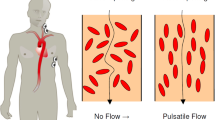Abstract
The performance of impedance cardiography (TEBco), using the BoMed NCCOM3-R7S, and thermodilution (TDco) were compared in eight patients during major abdominal surgery. An opioid, volatile and relaxant anaesthetic technique was employed. This was supplemented with an epidural in five cases. Sets of three cardiac output readings, for both methods, were made at 10–20 min intervals throughout surgery. Data were compared using the Bland and Altman method, regression analysis and a nested model to measure variance components at different stages of surgery. Data from 157 sets of readings are presented. Agreement between the two devices was poor, with a ratio of TDco/TEBco of 115% and limits of agreement of 51–193%. The regression line was TDco=(0.98)×TEBco-0.95 with r=0.60. A more detailed analysis, using nested data, showed good repeatability with coefficients of variation of 5.4% for TDco and 4.8% for TEBco. During surgery shifts in the bias between the two devices occurred, which were related to changes in surgical conditions. Between shifts both devices showed good repeatability over time. Variance components were 0.27 within nested data and 0.082 between bias shifts, with a significantly greater overall component of 1.2 (ANOVA; P=0.0001). Shifts could be explained by deficiencies in the algorithm used to calculate TEBco. Current TEBco technology is too inaccurate for intra-operative use. However, under stable operating conditions TEBco and TDco showed good repeatability.
Similar content being viewed by others
References
Parsa, MH, Tabora, F, Al-Sawwaf, M. Vascular access techniques. In: Shoemaker, WC, Ayres, S, Grenvik, A., Holbrook, PR, Thompson, WL. Textbook of Critical Care, 2nd Edn. Philadelphia: Saunders, 1989; 122–145.
Tremper KK. Continuous non invasive cardiac output: are we getting there? [editorial]. Critical Care Medicine 1987; 15: 278–279.
Wong DH, Tremper KK, Stemmer EA, O'Connor D, Wilbur S, Zaccari J, Reeves C, Weidoff P, Trujillo RJ. Non invasive cardiac output: simultaneous comparison of two different methods with thermodilution. Anesthesiology 1990; 72: 784–792.
Preiser JC, Daper A, Parquier JN, Contempre B, Vincent JL. Transthoracic electrical bioimpedance versus thermodilution technique for cardiac output measurement during mechanical ventilation. Intensive Care Medicine 1989; 15: 221–223.
Thomas AN, Ryan J, Doran BR, Pollard BJ. Bioimpedance versus thermodilution cardiac output measurement: the BoMed NCCOM3 after coronary bypass surgery. Intensive Care Medicine 1991; 17: 383–386.
Prepare the patient. In: BoMed Ltd, NCCOM3-R7S Cardiodynamic monitor operator's manual, Irvine, CA 92718, U.S.A.: BoMed Ltd, 1991; 15–17.
Kubicek WG, Kottke J, Ramos MU, Patterson RP, Witsoe DA, Labree JW, Remole W, Layman TE, Schoening H, Garamela JT. The Minnesota impedance cardiograph-theory and applications. Biomedical Engineering 1974; 9: 410–416.
Bernstein DP. A new stroke volume equation for thoracic electrical bioimpedance: theory and rationale. Critical Care Medicine 1986; 14: 904–909.
Nadeau S, Noble WH. Limitations of cardiac output measurements by thermodilution. Canadian Journal of Anaesthesia 1986; 33: 780–784.
Bland JM, Altman DG. Statistical methods for assessing agreement between two methods of clinical measurement. Lancet 1986; 1: 307–310.
Searle, S.R. Introducing linear models: Regression on dummy variables. In: Searle, S.R. Linear models, New York: Wiley and Sons, 1971; 155–159.
Stetz CW, Miller RG, Kelly GE, Raffin TA. Reliability of the thermodilution method in the determination of cardiac output in clinical practice. American Reviews of Respiratory Disease 1982; 126: 1001–1004.
Stevens JH, Raffin TA, Mihm FG, Rosenthal MH, Stetz CW. Thermodilution cardiac output measurement; effects of the respiratory cycle on its reproducibility. Journal of the American Medical Association 1985; 253: 2240–2242.
Okamoto K, Komatsu T, Kumar V, Sanchala V, Kubal K, Bhalodia R, Shibutani K. Effects of intermittent positive-pressure ventilation on cardiac output measurements by thermodilution. Critical Care Medicine 1986; 14: 977–980.
LaMantia KR, O'Connor T, Barash PG. Comparing methods of measurement: an alternative approach [editorial]. Anesthesiology 1990; 72: 781–783.
Jewkes C, Sear JW, Verhoeff F, Sanders DJ, Foex P. Non-invasive measurement of cardiac output by thoracic electrical bioimpedance: a study of reproducibility and comparison with thermodilution. British Journal of Anaesthesia 1991; 67: 788–794.
Castor G, Molter G, Helms J, Niedermark I, Altmayer P. Determination of cardiac output during positive end-expiratory pressure-noninvasive electrical bioimpedance compared with standard thermodilution. Critical Care Medicine 1990; 18: 544–546.
Fuller HD. The validity of cardiac output measurement by thoracic impedance: a metaanalysis. Clinical Investigative Medicine 1992; 15: 103–112.
Castor G, Klocke RK, Stoll M, Helms J, Niedermark I. Simultaneous measurement of cardiac output by thermodilution, thoracic electrical bioimpedance and Doppler ultrasound. British Journal of Anaesthesia 1994; 72: 133–138.
Tibballs J, Hochmann M, Osborne A, Carter B. Accuracy of the BoMed NCCOM3 bioimpedance cardiac output monitor during induced hypotension: an experimental study in dogs. Anaesthesia and Intensive Care 1992; 20: 326–331.
Spinale FG, Smith AC, Crawford FA. Relationship of bioimpedance to thermodilution and echocardiographic measurements of cardiac function. Critical Care Medicine 1990; 18: 414–418.
Northridge DB, Findlay IN, Wilson J, Henderson E, Dargie HJ. Non-invasive determination of cardiac output by Doppler echocardiography and electrical bioimpedance. British Heart Journal 1990; 63: 93–97.
Salandin V, Zussa C, Risica G, Michielon P, Paccagnella A, Cipolotti G, Giuseppe S. Comparison of cardiac output by thoracic electrical bioimpedance, thermodilution, and Fick methods. Critical Care Medicine 1988; 16: 1157–1158.
Author information
Authors and Affiliations
Rights and permissions
About this article
Cite this article
Critchley, L.A.H., Leung, D.H.Y. & Short, T.G. Abdominal surgery alters the calibration of bioimpedance cardiac output measurement. J Clin Monit Comput 13, 1–8 (1996). https://doi.org/10.1007/BF02918206
Received:
Accepted:
Issue Date:
DOI: https://doi.org/10.1007/BF02918206




